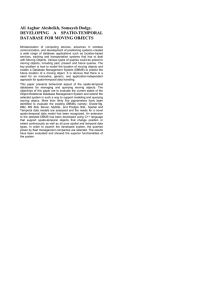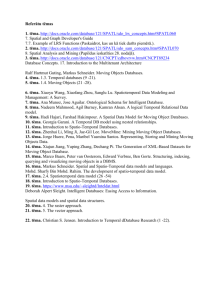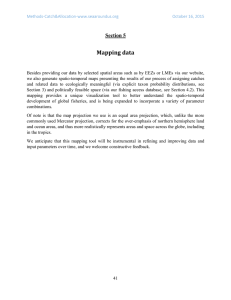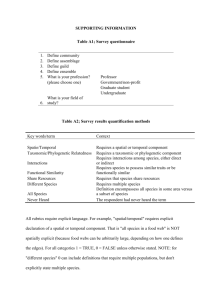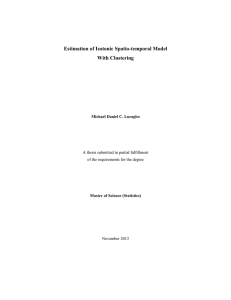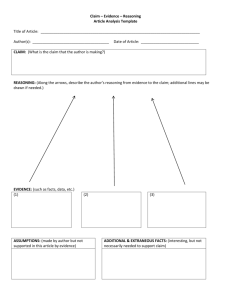A METHODOLOGY OF MODELLING OBJECT HISTORY ORIENTED TO SPATIO- TEMPORAL REASONING ,
advertisement
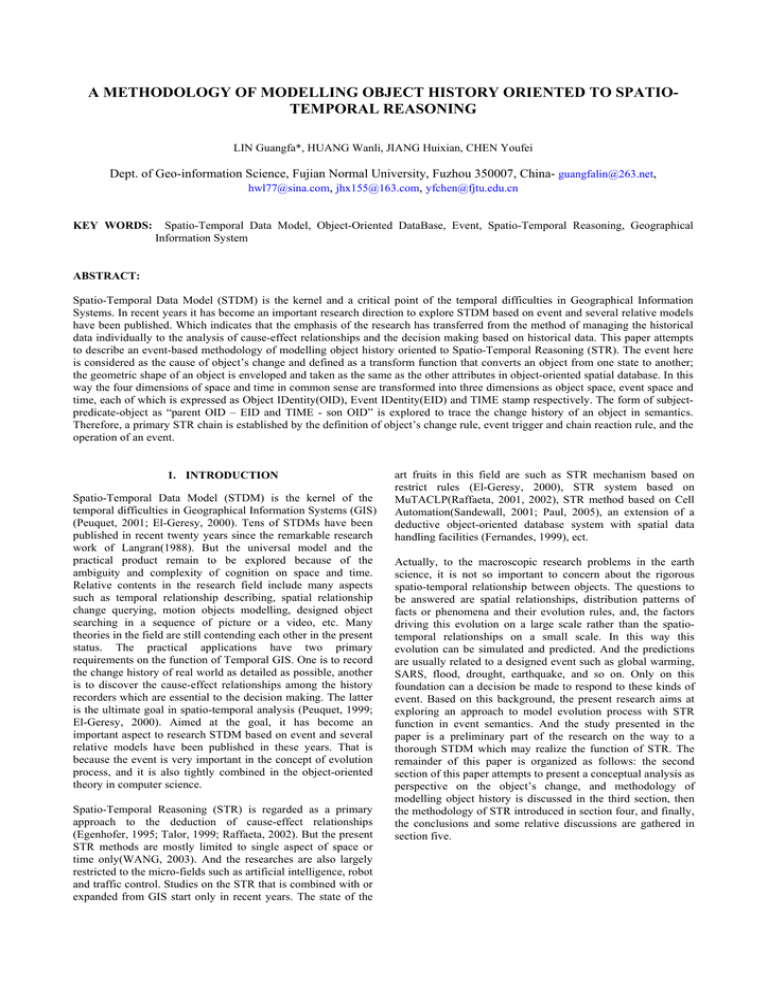
A METHODOLOGY OF MODELLING OBJECT HISTORY ORIENTED TO SPATIOTEMPORAL REASONING LIN Guangfa*, HUANG Wanli, JIANG Huixian, CHEN Youfei Dept. of Geo-information Science, Fujian Normal University, Fuzhou 350007, China- guangfalin@263.net, hwl77@sina.com, jhx155@163.com, yfchen@fjtu.edu.cn KEY WORDS: Spatio-Temporal Data Model, Object-Oriented DataBase, Event, Spatio-Temporal Reasoning, Geographical Information System ABSTRACT: Spatio-Temporal Data Model (STDM) is the kernel and a critical point of the temporal difficulties in Geographical Information Systems. In recent years it has become an important research direction to explore STDM based on event and several relative models have been published. Which indicates that the emphasis of the research has transferred from the method of managing the historical data individually to the analysis of cause-effect relationships and the decision making based on historical data. This paper attempts to describe an event-based methodology of modelling object history oriented to Spatio-Temporal Reasoning (STR). The event here is considered as the cause of object’s change and defined as a transform function that converts an object from one state to another; the geometric shape of an object is enveloped and taken as the same as the other attributes in object-oriented spatial database. In this way the four dimensions of space and time in common sense are transformed into three dimensions as object space, event space and time, each of which is expressed as Object IDentity(OID), Event IDentity(EID) and TIME stamp respectively. The form of subjectpredicate-object as “parent OID – EID and TIME - son OID” is explored to trace the change history of an object in semantics. Therefore, a primary STR chain is established by the definition of object’s change rule, event trigger and chain reaction rule, and the operation of an event. 1. INTRODUCTION Spatio-Temporal Data Model (STDM) is the kernel of the temporal difficulties in Geographical Information Systems (GIS) (Peuquet, 2001; El-Geresy, 2000). Tens of STDMs have been published in recent twenty years since the remarkable research work of Langran(1988). But the universal model and the practical product remain to be explored because of the ambiguity and complexity of cognition on space and time. Relative contents in the research field include many aspects such as temporal relationship describing, spatial relationship change querying, motion objects modelling, designed object searching in a sequence of picture or a video, etc. Many theories in the field are still contending each other in the present status. The practical applications have two primary requirements on the function of Temporal GIS. One is to record the change history of real world as detailed as possible, another is to discover the cause-effect relationships among the history recorders which are essential to the decision making. The latter is the ultimate goal in spatio-temporal analysis (Peuquet, 1999; El-Geresy, 2000). Aimed at the goal, it has become an important aspect to research STDM based on event and several relative models have been published in these years. That is because the event is very important in the concept of evolution process, and it is also tightly combined in the object-oriented theory in computer science. Spatio-Temporal Reasoning (STR) is regarded as a primary approach to the deduction of cause-effect relationships (Egenhofer, 1995; Talor, 1999; Raffaeta, 2002). But the present STR methods are mostly limited to single aspect of space or time only(WANG, 2003). And the researches are also largely restricted to the micro-fields such as artificial intelligence, robot and traffic control. Studies on the STR that is combined with or expanded from GIS start only in recent years. The state of the art fruits in this field are such as STR mechanism based on restrict rules (El-Geresy, 2000), STR system based on MuTACLP(Raffaeta, 2001, 2002), STR method based on Cell Automation(Sandewall, 2001; Paul, 2005), an extension of a deductive object-oriented database system with spatial data handling facilities (Fernandes, 1999), ect. Actually, to the macroscopic research problems in the earth science, it is not so important to concern about the rigorous spatio-temporal relationship between objects. The questions to be answered are spatial relationships, distribution patterns of facts or phenomena and their evolution rules, and, the factors driving this evolution on a large scale rather than the spatiotemporal relationships on a small scale. In this way this evolution can be simulated and predicted. And the predictions are usually related to a designed event such as global warming, SARS, flood, drought, earthquake, and so on. Only on this foundation can a decision be made to respond to these kinds of event. Based on this background, the present research aims at exploring an approach to model evolution process with STR function in event semantics. And the study presented in the paper is a preliminary part of the research on the way to a thorough STDM which may realize the function of STR. The remainder of this paper is organized as follows: the second section of this paper attempts to present a conceptual analysis as perspective on the object’s change, and methodology of modelling object history is discussed in the third section, then the methodology of STR introduced in section four, and finally, the conclusions and some relative discussions are gathered in section five. 2. PERSPECTIVE ON THE OBJECT’S CHANGE PROCESS On the semantic level, there are two the most important problems to be solved in constructing an STDM: one is to identify and to trace the changing object, and the other is to express the reason of change. This section analyses the change process in these two aspects. 2.1 On Identifying and Tracing Object During System Evolution Firstly, some definitions are given as follows. Definition 1 Object: an entity can be separated and identified in the real world. Be undistinguished, the virtual expression of the entity in the computer system is also defined as object. An object may be a physical entity such as a plot, a house, or a virtual entity such as the right of a property which is significant in law only. Definition 2 Attribute: characters or components of an object must be provided to describe it in a designed purpose. In the frame of object-oriented theory, an attribute also is to be an object when it is a component. In this case, the attribute is in dualism to be an unattached object or an attached attribute to another object. The attributes can be divided into two catalogues, essential attributes and contingent attributes. Definition 3 Kernel of an object: a group of essential attributes of an object that can be used to identify an object class. Definition 4 Qualitative change of an object: each attribute has a field of definition, and qualitative change happened when the value of an essential attribute goes beyond the field. It is a universal rule in the real world that the object has a hierarchical structure and the levels are almost to be endless in the structure. So, changes in any level of attribute imply that there are infinite objects with this attribute in different granularity to be changed. Therefore, a scale is always destined for a given research goal to limit the range of levels. During the process of building a spatial database for a special application, all object classes should be enumerated and all objects in these classes should be defined in modelling objects of the scale. And, it is an important task to maintain the succeeding relationships among object instances in temporal databases of any two points of time during the evolution of the databases. 2.2 On Describing Reason of Change The cause-effect relationships can be discovered in two approaches. One is to deduce from the temporal relationships among objects. For example, a sequence of states in an evolution of objects can be ascended via the time stamps or pointers with the objects, and then cause-effect relationships may be deduced. But sometimes the approach may not be available because the temporal relationships do not always indicate the cause-effect relationships. For instance, the successive tenants of a house maybe appear randomly. So, another approach must be employed, that is, to record an event happened directly. As a fundamental factor driving the change of real world, the event is all the way one of the primary issues in temporal GIS. Much more attention has been paid to it especially after the introduction of object-oriented theory in which the event is valued as one of essential concepts. A universal definition of the term, however, is yet to be given in the present research status. Peuquet(1995) defined the event as an instant of state’s change, and then an event is opposed to a state. JIANG(2000) defined the event as the steps of workflow in an official transaction in a case of land planning. HE(2000) divided the event into three classes as system event, real world event and user event in active database. Yuan(2001) defined the event as a significant incident happened such as a flood, a continuous drought, or a kind of change tendency. All these definitions reflect the differences of cognition about reason of change at various levels and from different points of view. Explicitly, here in the research case discussed in the paper, a definition of event is also given as follows. Definition 5 Event: in case of an interaction between object A and object B, if the behaviour of A leads to a change of B, then the behaviour is to be an event happened to B. For instance, wrecking of a house will lead to the rights of the house to be invalid, then that is an event happened to the right object. In the process, the event can be considered as a transform function E, which converted the object O from state of Ot in instant t to state of Ot+1 in instant t+1. In the function, input Ot and then output Ot+1 , that is, Ot+1=E(Ot). Just the same as that of an object, the event also has a hierarchical structure. For example, in active database, the events is divided into atom events and composite events belonged to different levels(HE, 2000). 2.3 On the Relationship Between Objects and Events In some of the STDM, the event is considered to be one of an attribute of the object. In fact, an event is shared by a part of objects through the time and space but dominated by an object particularly. An object will be affected by many events and an event will act on many objects at the same time. Therefore, all the events in the system of the present research are separated out to be an independent systematic space—event space, which stands in the same field with object space and time. There are at least three advantages in the frame: (1) be easy to set up rules of data updating; (2) be convenient to maintain the data integrality and consistency during the data updating; (3) be possible to perform queries on a particular event, which is regarded as one of the most significant functions. The structure of event space is corresponding to that of object space, i.e., events in large granularity will also act on objects in the same level of granularity. 2.4 On Reasoning Mechanism The mechanism of reasoning depends on the construction of a set of meta-rules. There are four kinds of rule in building an inferential chain in the research: (1) rules of object’s change; (2) rules of triggering an event; (3) rules of event’s action; (4) rules of chain reaction of events. Actually, the rules are extracted domain knowledge based on the comprehensions of a particular application. 3. METHODOLOGY OF MODELING OBJECT HISTORY In the above conceptual frame, the four dimensions of space and time in common sense are transformed into three dimensions as object space, event space and time. The object space expresses the entity including its geometric shape, and the event space expresses the semantics of change. Then the task of modelling object history is to associate the object’s history with the events driving the change and the time of change. 3.1 To Describe Object’s Structure Major headings or section headings are to be centered, in bold capitals without underlining, after a triple line space (two blank lines) and followed by a double line space (one blank line). Latter is done automatically when using the provided Word template file. Most of the existing spatial data structures emphasize the modelling of geometric structure under the spatial hierarchical theory of points, polylines, polygons and the solid body of an entity. This is incomplete in reflecting the actual semantics of the hierarchical structure of objects because the practical application concerns more on the topological relationships of the temporal, the conceptual, and the spatial between objects than that of the geometric in an object. So, the geometric structure enveloped in GeoDataBase(Zeiler, 1999), an objectoriented spatial data model, is considered as an ordinary attribute as the other attributes. Attributes belonging to different level are stored in different tables (Figure 1.). 3.2 To Manage Object Identities One of the purposes to identify an object is to mark the start and the end of the lifespan of an object explicitly in tracing its history. The method to manage the identities is as follows: (1) to classify the objects; (2) to decompose each object class into a structure tree (Figure 1.) according to the requirements of practical application; (3) each node on the tree is a subclass of the object; (4) to define a “kernel” for object of each subclass; (5) each instance of any object subclass has a character type identity; (6) the identity will never be deleted or modified, it is always be appended; (7) the identity is consistent with the object in their lifespan. 3.3 To Model Events The task of modelling event is to transform the event in real world into that in the computer system. The specific work to be finished is to fulfil a table of atom events as the following structure: EvenTable(Even Type, Even Name, Even ID, Trigger Condition, Semantic Description, Operations, Objects be Operated on) The field “Trigger Condition” in the table is designed to store rules of whenever a specific event will be triggered and, with which the relationships of nest or succession between events can be described. These rules include such as the exceeding of a predefined field domain of a specific attribute, the ending of an object, or the happening of a composite event, and so on. 3.4 To Manage Event Identities The method to manage event identity is the same as that of object. But the event identity will never be ended, the structure of an event is much more simple, and the number of events is also much smaller. 3.5 To Embed Rules The rules include event’s action rules and object’s change rules. The object’s change rules are controlled by domain of attributes. The domain and its relative operation (event) are embedded in the definition of attributes directly when a database is built. The event’s action rules are expressed in the two fields as “Trigger Condition” and “Operations”. And the “Operations” should be realized via program. 3.6 To Trace Object’s History Figure 1. Hierarchical Structure of an Object Table structure of the first level: O (OIDo, A1, A2, …, OIDai, Ai+1); Table structure of the second level: Ai (OIDai, Ai1, Ai2, Ai3) In the table of first level, Ai is replaced by OIDai. The object identities are employed in association and navigation among objects of varied levels. All the STDMs are snap-shot method essentially. The difference between varied STDMs lies in the granularity and storing method of snap-shots. In the present research, snap-shot is taken on the one upper level of the changed attributes. This is a method with data redundancy to a certainty. To trace the change history of an object in semantics, two snapshots with succeeding relationships are stored in the form as figure 2. Which means that event E happened to parent object PO at time TIME, and then PO changed into son object SO. The form of subject-predicate-object as “POID-EID-SOID” expresses the primary semantics of an event, and the cause of object generation change can be judged explicitly. POID EID,TIME SOID Figure 2. A Conceptual View of OET Model (POID: Parent Object Identity, SOID: Son Object Identity, EID: Event Identity, TIME: Instant of Event happened) granularity related to composite event from the simple causeeffect relationships related to atom event; (2) the micro causeeffect connection between object of large granularity; (3) the characteristic of spatial relationship reflected by the causeeffect relation; (4) to debug the evolution process of system by change the rules intenionally. 5. CONCLUSION AND DISCUSSION Therefore, the structure of spatio-temporal database with temporal dimension, in the case of table Ai in figure 1, is showed as follows: Ai (OIDai, Ai1, Ai2, Ai3, Time, EID, SOIDai) For each change of Ai, a new recorder is appended into the database, and the corresponding old recorder is stamped with the time and EID and then becoming a historical recorder. The EID expresses the event leading to the change. If the change triggered other objects to be changed, then the chain of object’s evolution guided by event database will be recorded. 4. METHODOLOGY OF SPATIO-TEMPORAL REASONING It is a difficulty in STDM to describe the three or four dimensions of space and time and to query in it. Most of the existing models are designed to find a solution to difficulty. The present research, however, attempts to focus on the practical signification of the object’s change rather than the solution. The geometric shape is enveloped as an ordinary attribute of an object in the object-oriented GeoDataBase. The time and space are transformed into object space, event space and time. And each is expressed as object identity, event identity and time stamp respectively. The evolution history and changing causes of object are traced by recording the objects, events and time correlated in each process of change. And, a primary STR chain is established by the definition of object’s change rule, event trigger and chain reaction rule, and the operation of an event. Thus the mechanism of STR is founded based on the structure of the spatio-temporal database. 4.1 Method of Query There are four kinds of relationship between objects that can be employed for query: (1) temporal relationship via time stamps and POID-SOID; (2) spatial relationship queried by the function of GIS software; (3) object relationship via object identity or other defined user identity; (4) cause-effect relationship via event identity. However, some rigorous conditions will be applied in using the method: − − − 4.2 Method of Pattern Discovering Based on OID-EIDTIME During the process of operation, no object will be deleted physically in the database system, and it can be appended, modified or logically deleted (be put into the history database) only. So, the OID and time stamps are exclusive and increased in linearity. And then, the OID and time stamps construct a two-dimensions grid, in which every segment on the time dimension is corresponding to the lifespan of a certain object in the system exclusively. The two end points of the segment express the beginning and the end of the lifespan of the object. On each point there is at least one event recorded as EID. − − It must be a discrete change process and time; The structure character of spatial object and the rule of attributes’ change must be very explicit; The structure, connotation, operation of each event and the chain reaction relationship among events in the application system must be analysed and defined first; Thus, the method is applicable to the “from bottom to top” case of deducing unknown macro character by the known micro character of objects; The pre-defined meta-event driving system covers a fatal problem to be solved—contradictory operations on the same object would happen when several events are triggered at the same time, and some of the events would compose a closed chain of operation and finally all these cases will result in an endless repeatitive operations in the system evolution. In the extremely simplified three-dimension space as OID-EIDTIME, ordinary statistics methods can be employed to analyse the pattern of change. Some significant results such as the frequency of change or of event happened, the character of object’s change in a specific range of time, the action range of a specific event, could be acquired. The following study of the research is to apply the model in the analysis of the recent twenty years’ evolution of wetland of Xiamen city, a coastal city in southeast of China. A very important subject in the project is to divide and estimate the different infections of humanistic factors and physical factors. 4.3 Method of Spatio-Temporal Reasoning Based on Event Deduction REFERENCES The theory of active database and deductive database is introduced into the spatio-temporal database in the research. The mechanism of STR is established based on the object’s change rule in the object database, atom event table and the relationships between events within a reaction chain that are store in the event table. Some of the methods of STR are listed as follows: (1) to deduce cause-effect relationship in a large References from Journals: El-Geresy BA, Abdelmoty AI, Jones CB, 2000. Episodes in space: qualitative representation and reasoning over spatiotemporal objects. IJAI Tools, 9(1), pp.131-152. Fernandes AAA, Dinn A, Paton NW, et al., 1999. Extending a deductive object-oriented database system with spatial data handling facilities. Information and Software Technology, 41(), pp.483-497. JIANG Jie, CHEN Jun, 2000. Some thoughts on spatiotemporal database of land planning based on event. Journal of ACTA Sinic. 29(1), pp. 65-70. Langran G, Chrisman N. R. A, 1988. A framework for temporal geographic information. Cartographica, 25(3), pp. 1-14. Paul M. Torrens and Itzhak Benenson, 2005. Geographic automata systems. IJGIS, 19(4), pp. 385-412. Peuquet DJ, 2001. Making space for time: issues in space-time data representation. GeoInformatica, 5(1), pp. 11-32. Peuquet DJ, Duan N, 1995. An Eent-based Spatio-Tmporal Data Model (ESTDM) for temporal analysis of geographical data. IJGIS, 7(1), pp. 7-24. Talor K, Waler W, Abel D, 1999. A framework for model integration in spatial decision support system. IJGIS, 13(6), pp. 533-555. WANG Shengsheng, LIU Dayou, XIE Yi, 2003. Qualitative reasoning based on the integration of multi-aspect information and its application. Journal of Software, 14(11), pp. 1857-1862. Yuan M, 2001. Representing Complex Geographic Phenomena in GIS. Cartography and Geographic Information Science, 28(2), pp. 83-96. References from Books: HE Xingui, TANG Changjie, LI Lin, LIU Yunsheng, 2000. Technology of Special Type Database. Beijing: Science Press, pp. 81-111. Zeiler M, 1999. Modeling Our World: The ESRI Guide to Geodatabase Design. California: ESRI Press, pp. 1-21. References from Other Literature: Egenhofer M, Mark D, 1995. Naive Geography. In: COSIT’95, Volume 988 of LNCS, Springer: pp. 1-15. LIN Guangfa, 2003. An Event-based Spatio-Temporal Data Model. PhD Dissertation, Nanjing University, pp. 5-16. Peuquet DJ, 1999. Time in GIS and geographical databases. In: Longley PA, Goodchild MF, Maguire DJ, Rhind DW. Geographical Information Systems (2ed). New York: John Wiley & Sons, Inc, pp. 91-103. Raffaeta A, Renso C and Turini F, 2001. Qualitative reasoning with a spatio-temporal language. International Workshop on Complex Reasoning on Geographical Data. ACM, pp. 42-48. Raffaeta A, Renso C and Turini F, 2002. Enhancing GISs for spatio-temporal reasoning. ACM GIS’02, pp. 42-48. References from websites: Sandewall E, 2001. Cellular ontology as a basic for spatiotemporal reasoning. http://www.ep.liu.se/ea/cis/2001/011/. (accessed 15 Jan. 2004) ACKNOWLEDGEMENT This research is supported by the national Natural Science Foundation of China(NSFC) under grant No. 40401049 and innovation foundation for young science researchers of Fujian province under grant No. 2003J007.
